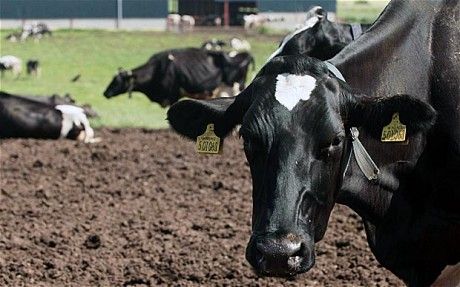
© Press AssociationResearchers say they are able to create cows that produce milk containing a human protein called lysozyme
The scientists have successfully introduced human genes into 300 dairy cows to produce milk with the same properties as human breast milk.
Human milk contains high quantities of key nutrients that can help to boost the immune system of babies and reduce the risk of infections.
The scientists behind the research believe milk from herds of genetically modified cows could provide an alternative to human breast milk and formula milk for babies, which is often criticised as being an inferior substitute.
They hope genetically modified dairy products from herds of similar cows could be sold in supermarkets. The research has the backing of a major biotechnology company.
The work is likely to inflame opposition to GM foods. Critics of the technology and animal welfare groups reacted angrily to the research, questioning the safety of milk from genetically modified animals and its effect on the cattle's health.
But Professor Ning Li, the scientist who led the research and director of the State Key Laboratories for AgroBiotechnology at the China Agricultural University insisted that the GM milk would be as safe to drink as milk from ordinary dairy cows.
He said: "The milk tastes stronger than normal milk.
"We aim to commercialize some research in this area in coming three years. For the "human-like milk", 10 years or maybe more time will be required to finally pour this enhanced milk into the consumer's cup."
China is now leading the way in research on genetically modified food and the rules on the technology are more relaxed than those in place in Europe.

Comment: There is one proven technique that can assist you with managing pain, reducing stress, calming and focusing your mind, creating better links between body and mind and thus improving quality of life, increasing sense of connection with others in your community. It will help you to have improved overall health, a stronger immune system, better impulse control, reduced inflammation, etc. It will also help you to heal emotional wounds; anything that may hinder or prevent you from leading a healthy and fulfilling life.
The Éiriú Eolas technique grew out of research conducted by the Quantum Future Group under the direction of Laura Knight-Jadczyk and Gabriela Segura, M.D. The practice has been thoroughly researched and proven to work by the thousands of people who are already benefiting from this unique program. The effects are cumulative and results and benefits can be seen in only a very short time, sometimes after just one session!
There is a myriad of relaxation techniques out there, but not many of them can attest to having not only immediate effects, but also having a highly practical application. With Éiriú Eolas, there is no need to sit in special postures, or be present in a carefully prepared relaxing atmosphere. The strength of the program comes from its high adaptability to stressful conditions of the modern world. Anyone can do it, be it a student, sitting outside of a lecture hall before the exam, a mechanic needing a break from tackling problems all day, a businessman just before signing an important deal, a mother having to raise three children and worrying if she will have enough money to pay the mortgage, etc.
Visit the Éiriú Eolas site or participate on the forum to learn more about the scientific background of this program and then try it out for yourselves, free of charge.